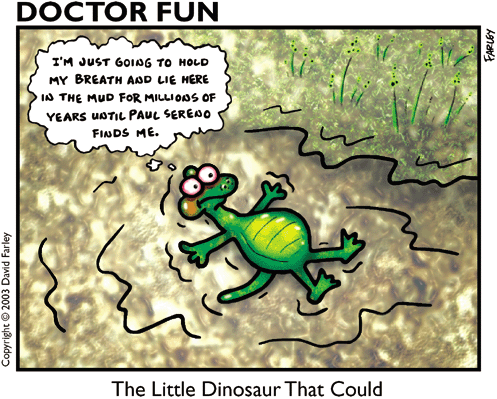 Chicago
Journal
Chicago
Journal
A techie called Doctor Fun
A forthcoming book from Chicago examines
physics, chemistry, paleontology, biology, literature, and
American culture. But it’s hardly an academic treatise.
Doctor Fun: Greatest Hits, 1993–2003 (Plan
Nine Publishing)—a collection of single-paneled, animal-charactered,
idiom-twisting cartoons in the tradition of Gary Larson’s
The Far Side— comes from David Farley, U
of C Libraries technology-support manager by day, Web cartoonist
by night.
The cartoon’s title harks back
to Farley’s mid-1980s college days, begun at Case
Western and finished at Millersville University, when he
began doodling with pen and paper. A Millersville political-science
professor had called himself Doctor Fun during ad-hoc, out-of-class
lectures. “It had the same initials as my name, and
I just kept coming back to it,” says Farley, 39, whose
reddish-brown hair and boyish looks recall Philip J. Fry,
the lead character in Matt Groening’s Futurama.

Today—a decade after Doctor
Fun became the first Web cartoon—the site gets
about 45,000 hits a day, plus untracked hits from mirror
sites and links from bloggers and other fans. To create
each cartoon Farley spends about two hours at a large worktable
in his Hyde Park apartment, using a stylus to draw directly
onto his Sony Vaio computer screen, which bends backward
to lie flat. Until 2001 he drew on a flat plastic drawing
pad while watching his marks appear on the screen before
him, an impressive trick of hand-eye coordination. Earlier
he drew the cartoons on paper and scanned them. He’s
used Adobe PhotoShop to color the drawings since 1995.
Farley usually finishes one Doctor
Fun a night, working a few weeks in advance. He scribbles
down ideas from books he reads (currently a pop-science
book on ants) or comments he hears. At times the University
makes subtle appearances in Doctor Fun, like when
a campus photo of the Regenstein provides a cartoon’s
background. Other Chicago references are more forthright,
poking fun at Paul Sereno or the first self-sustaining nuclear
chain reaction.
Farley began working at the Reg in 1990,
during the Internet’s infancy. “The library
wasn’t networked, and there were only three people
supporting computers,” Farley says from his corner
office near the A-level stacks. The wooden desks, metal
bookshelves, and blue-green carpet overflow with cardboard
computer and software boxes, old computers and keyboards,
wayward cables, and a few empty Rolling Rock bottles.
It was fellow Reg techie Keith Waclena
who told Farley about a new computer network called the
World Wide Web. In 1993 Farley published his first Doctor
Fun cartoons on a server run by Waclena—“probably
the University’s only server at the time.” Thus
Doctor Fun became the first Web cartoon (but not
the first on the Internet, a distinction Farley is quick
to credit to Hans Bjordahl’s Where the Buffalo
Roam).
After about three months Waclena’s
computer had some problems, and he took the server down.
“It was one of only about ten things on the Internet
at the time,” Farley says, so when Doctor Fun
disappeared, “people noticed.” One fan offered
Farley real estate at what is now ibiblio.org, a cyber library
run by the Center for the Public Domain and the University
of North Carolina–Chapel Hill. It’s still Doctor
Fun’s home.
Although he has admirers in academe and
the high-tech world—Sereno asked Farley for a copy
of the cartoon mentioning him, and Farley once designed
a Doctor Fun cake for Bill Gates—Farley knows
he could probably promote the cartoon beyond its current
fan base. At some Web-cartoon conventions, he admits, few
people know about Doctor Fun. Hence the book, expected
out this summer. Farley also is considering a venture with
CafePress.com, which creates and sells custom merchandise
online, and advertising on other Web cartoonists’
sites. Perhaps Chicago is witnessing the makings of the
next Larson or Groening, hidden in a corner near the A-level
stacks.
—A.B.
(Doctor Fun is at www.ibiblio.org/Dave/drfun.html—Ed.)


![]() Advertising
Advertising
![]() About
the Magazine
About
the Magazine ![]() Alumni
Alumni
![]() UChicago
UChicago
![]()
![]() ©2003 The University
of Chicago® Magazine
©2003 The University
of Chicago® Magazine ![]() 5801 South Ellis Ave., Chicago, IL 60637
5801 South Ellis Ave., Chicago, IL 60637![]() fax: 773/702-0495
fax: 773/702-0495 ![]() uchicago-magazine@uchicago.edu
uchicago-magazine@uchicago.edu
